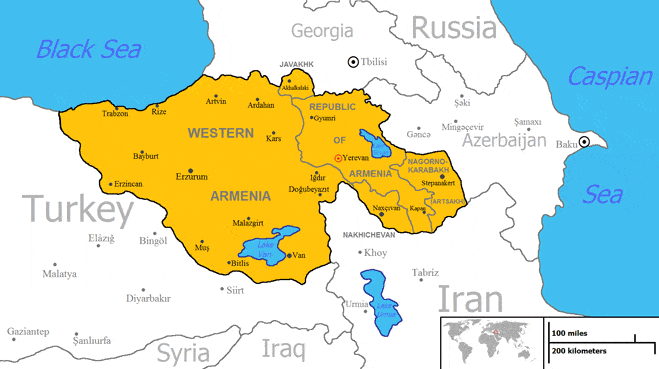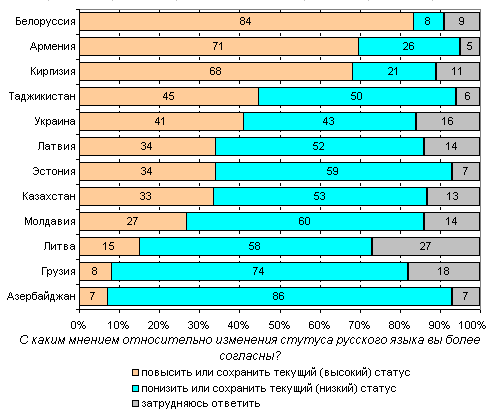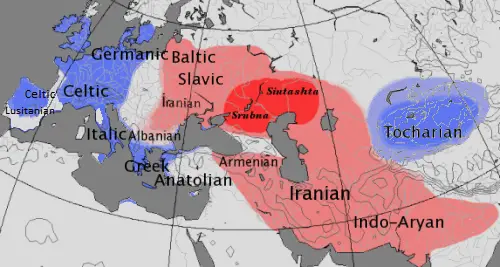The base of both Eastern and Western Armenian is the Classic Old Liturgical Armenian. They were the dialects of geographically divided Eastern and Western Armenia. During the Soviet Era, drastic changes were made in Eastern Orthography.
Iranian Armenians use Western spelling, but Eastern somehow softer Pronunciation. Western Armenian is very well preserved in the Diaspora as it is still taught in schools used in Diasporan Armenian institutions.
Despite having the same roots, eastern & western Armenian have many differences, such as pronunciation, grammar, and spelling. Western Armenian still follows ancient orthography rules, while Eastern Armenian orthography reformed and adjusted phonetic realization and writing.
Nowadays, you will hear Eastern Armenian in almost every community of the Diaspora, especially after the great number of citizens of the Republic of Armenia who chose to migrate and relocate to Europe, America, and elsewhere. Some schools in the Diaspora have also added Eastern Armenian to their curriculum. And as Saroyan once said, whenever two of them meet they create a new Armenia.

A quick review of the differences between Eastern & Western Armenian.
Pronunciations: Some consonants are stressed and others are spoken in a softer way in Armenia. Some of these sounds are mainly affected by Russian and Georgian languages.
| Western | Eastern |
| բ-pen | B |
| գ-kim | G |
| դ-Ta | D |
| ձ-Tsa | Dj |
| ջ-Tche | Dj |
| Western | Eastern |
| փ-Pure | p |
| ք-Kai | K |
| թ-To | T |
| ց-Tso | Ts |
| չ-Tcha | Tch |
Words: Most of the words used are in common. The roots of the words are basically one, they both come from the same classical Armenian. A few different words and conjunctions in Western Armenian are absent from Eastern Armenian.
Grammar: The main difference in grammar is how roots are inflected and connected to form the correct tense, depending on the dialect. Simple future in western Armenian uses “bidi-piti” as in “i will”, in Eastern Armenian, it simply means the word “will”.
Spelling: Western Armenian has preserved Classic Orthography. Eastern Armenian spelling was created in Soviet Armenia and adopted Officially in 1940 by Manouk Apeghyan.
The Classic Western Armenian Orthography is still in use at the Armenian Orthodox Church of Armenia. The Bible in the Eastern Armenian dialect is written in western.
To learn the base of Armenian orthography, to know where the roots of words come from, and write them correctly, it is essential to know Western Armenian.
Western Armenian Language dialect (Numbers, Greetings, Words & The Parable)
How similar are Western and Eastern Armenian?
Western and Eastern Armenian words share the same roots, just different dialects. Just like understanding Latin-based words from their roots, Armenian is also one language with the same root just different rules. They both come from the Classic Old Liturgical Armenian.
The Liturgical Armenian flowered and reached its Golden Age when the Armenian Alphabet was first invented. It was important because it united the Armenian people, who were using foreign alphabets in their official documents, but didn’t have to anymore.
Western Armenia was under Byzantine rule, and Eastern Armenia was under Persian rule. The only way to unite the Armenian people was with one language and one Alphabet. Everything was soon translated into Armenian. Although every region had its own dialect (more than 50) the Bible came to unite them all.
How Did Armenia Divide
Western Armenia ended up under Ottoman Rule, where it was forbidden for Armenians to speak, pray or study Armenian. It all changed at the beginning of the 19th century when Sultan Abdul Majid came to rule in 1839. There was a new European presence in Constantinople, reforms were made in regard to the “Equality of Non-Muslims”.
This gave Armenians a chance to improve their lives, social, political, and economical status and build schools and colleges. Constantinople or Istanbul was the center of this Revival especially because the Armenian Patriarchate was located there since 1461.
Intellectuals started translating Liturgical Armenian to “Worldly” Armenian, these were likes of Madteos Mamourian, Krikor Chilingirian, Mesrob Noubarian, Garabed Utidjian, and many more.
Western Armenian Literature Revival
Governor Shnork Mgerditch had already started establishing many educational institutions in Constantinople in 1779. Some intellectuals pursued higher education in Saint Lazarus Mekhitarist Monastery (1717), like Daniel Varoujan and Mkertitch Beshigtashlian.
Armenian Literature was taken to another level by intellectuals like Father Ghevont Alishan, Father Khrimian, Bedros Tourian, Thomas Terzian, Srabion Hekimian, and Dzerents (Dr. Hovsep Shishmanian), Serpouhi Dusap, Hagop Baronian… Krikor Zohrab, Yeroukhan, Yervant Odian, Zabel Asadour…
We all know how it ended for the intellectuals when parallel to the reforms atrocities were committed against the Armenian People. After the events of the Armenian Genocide in 1915, Descendants of Western Armenians spread all around the world. They are the Diasporan Armenians who built Churches and schools in every corner of planet earth preserving the Western Armenian language.
Eastern Armenian Revival and Division
Meanwhile, Armenia, Artsakh, Russia, and Georgia were under the rule of the Russian Empire. Armenians have more freedom and are greatly influenced by Russian and European Culture. New universities were opening, and many Armenian doctors, engineers, lawyers, and educators were there.
Eastern Armenian Intellectuals were the likes of Khachadour Abovyan, Mikael Nalpandyan (the Poet behind the Armenian Anthem in use nowadays), Berdj Broshyan, Ghazaros Aghayan, Raffi (Hagop Melik Hagopian), Santougyan, Smpad Shahaziz…
They were well aware of the destiny of their brothers in western Armenia and wanted to reach out. This motivated Caucasian Armenians to get organized, start a movement, write and motivate others, but they were not getting support from the Russian Empire.
The Eastern Armenian Literature Revival yielded many masterpieces such as the Armenian Anthem which was inspired by the formation of a unified Italy. It was initially called The song of the Italian Girl, probably because their works were censored, but it represented the ugly truth in our motherland Armenia.
This song is disliked by many patriots today although cherished by many who believed in the dream of Armenia.
Events Leading to Change in Eastern Armenian Orthography
Armenia was being filled with Russian settlers so that there would be no space to help Armenians fleeing the Genocide. In 1903 a Prince was sent to Armenia to confiscate the belongings of the Armenian Church to weaken the educational system of Armenians.
This all was interrupted by the Independence of Armenia on 28, May 1918. But was continued during the Soviet Armenia era. When the Soviet government wanted to put the Russian Alphabet in use in the Armenian SSR to separate both dialects once and for all; to forever separate the Armenian nation from what kept them united for centuries.
The mission was handed to Manouk Apeghyan. He suggested changing the Armenian Orthography, and including Russian words in the vocabulary, probably to prevent the complete disposal of the Armenian Alphabet and identity.
Who is the father of Modern Armenian?
The father and creator of Modern Eastern Armenian is Manouk Apeghian. An intellectual who has been to various Armenian villages and has collected and preserved old Armenian folktales, poems, myths, etc. He was born on March 15, 1865, in Old Nakhichevan’s Asdabad village, in a family of farmers. He passed away on 25 September 1944.
He received his early education in the local school of “Garmir”- Red Monastery. Later(1876) he attended the Gevorgyan Jemaran (Seminary) of Ejmiadzin. After graduating in 1885, he was asked to teach at his own Gevorgyan Seminary, in addition to the Armenian Churches’ schools in Shoushi and Tbilisi.
In 1838 he left for Europe to continue his education at Leipzig, Berlin, and Paris universities. He returned after receiving a Doctorate of Philosophy in 1898. He taught at Ejmiadzin’s Jemaran until 1914.
For the next 4 years, he taught at Tbilisi’s Nersisyan School until the Independence of Armenia in 1918.
After the Independence, he moved to Yerevan as a Professor of Armenian History and Language. He headed the Soviet Armenian Science and Arts Institution from 1925-30.
What is the Most Common Language Spoken in Armenia?
The most commonly spoken languages in Armenia are Armenian and Russian. Armenian is the official language but Russian, English, and French are also taught at schools as secondary languages. According to Russian official sources, almost 70 percent of Armenians speak Russian.
After the Arab Spring, and the Lebanese crisis, many Diasporan Armenians relocated to Armenia, although these are western Armenian speakers, they are also efficient in Arabic, English, and French.

Should I learn Eastern or Western Armenian?
Before you decide to learn either one, it is important to ask yourself how and where you will be using it. If you wish to communicate with a particular Armenian person, you better choose whichever dialect this person uses. Whatever the case, this person will understand and will be able to share with you.
The Armenian Alphabet is 38 letters whether it is Eastern or Western. The roots are the same, but if you know some Russian, Eastern Armenian might be the one for you.
Can Eastern Armenians understand Western Armenian?
Eastern and Western Armenians understand each other well. It needs some time to follow the pace and there will be no problem understanding each other.
Do not forget that nowadays after TV and Satellite, the internet connects everyone and people are exposed to new languages or dialects through music or videos.
Is the Armenian language dying?
No, The Armenian Language is not Dying, it is immune and immortal. Admitting it could die means something completely out of Armenian Caracter. Young couples who never learned the language insist on teaching their children the language or getting them involved in cultural life.
The Armenian people have survived thousands of years. Their language has survived as long as they have. Today about 10 million people around the world speak Armenian. Many new Armenian schools are functioning every day. It doesn’t seem like it’s dying anytime soon.
A few years ago an Armenian song by American- Armenian rapper Super Sako became a hit online, and everybody was singing “Mi Gna” -Don’t Go, for a couple of years.
As long as there is the Armenian soul on earth’s face the Armenian language will never die. The language is safe as long as Armenians feel Armenian.
According to UNESCO, the Western Armenian Language is listed as A DYING LANGUAGE
Why is Armenian so hard to learn?
Armenian is not hard to learn, it is very easy, and we can prove it to you. Moreover, we can suggest professional online teachers for you to see for yourself.
Armenian is not hard to learn or teach. I know this because I was 10 years old when I decided to teach my grandma’s Lebanese, Arabic-speaking neighbor’s son Armenian. In a few days, I managed to teach him whatever I knew and he knew better Armenian than I knew Arabic at that age.
The letters are easy to learn; just 36 of them. Nowadays the characters of a movie or a game are more than that. For me, it’s easier than Greek, Arabic, or French, because there are no genders for pronouns nor nouns or verbs.
What Language is Armenian closest to?
The Armenian Language is part of the Indo-European family. It has its own place between Greek and Indian languages. It is said to be closer to the extinct Phrygian Language.

Modern Armenian has adopted many neighboring Persian, Russian, Iranian, and Greek words; in addition to French from the Crusaders. It is unique with its Alphabet, but you still hear familiar words, making it seem close to English, French, Greek, Arabic, Iranian… etc…
They have adopted the way Georgians and Caucasians pronounce a strong T making it sound like a D, and the huge number of Russian words that were Armenianized by the soviet scholars gives the impression Eastern Armenian is closer to Russian.
Scholars Henry Petermann and Friedrich Müller, proved that Armenian is an independent branch within the Indo-European family of languages. Henry Petermann is Author of “Brevis Linquae Armeniacae: Grammatica, litteratura, Chrestomathia cum glossario” , and Friedrich Müller, founder and main advocate of the so-called “linguistic ethnography”, (see Müller, “Über die Stellung des Armenischen im Kreise der indogermanischen Sprachen” Sb. der Akademie der Wissenschaften 84, 1876/77, pp. 211-32).

French Linguist Meillet, Antoine (1866-1936) dedicated a whole book to the Armenian language “Grammaire comparee de l’armenien classique” in 1903.
E. Dulaurier is amazed how the Armenian language is easy, flexible, and young, and has the ability to expand even more; as he writes on 15 April 1854, p.211 of LA SOCIÉTÉ ARMÉNIENNE CONTEMPORAINE, Revue des Deux Mondes.
What Language did Armenians speak before Armenian?
Before the arrival of Armens, Armenia was inhabited by Haldi People, in the Kingdom of Urartu, located near lake Van, as mentioned by inscriptions by Assyrian King Ashurnasirpal (885-860 BC).
” The Language of Urartu was not Semitic nor Hittite, but probably Caucasian” A. Sayce, The Kingdom of Van(Ourartou), Cambridge Ancient History, II, P. 172.


Fascinating the different dialects, ……that’s why I couldn’t understand some of the languages, from what I learned as a child. Although I have lost most Armenian I learned, I do pick up words now and then…..I’m 88 yeas old, born in America to my immigrant parents that survived the Holocaust of 1915-18…my mother was born in Izmir, my father in Stepastia , or Sevas, …..When first hearing some of the language on the internet , I didn’t think they were speaking Armenian until it dawned on me about the different dialects.